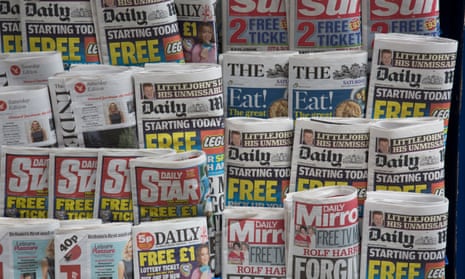- The former managing director of the Mail titles, Guy Zitter, reflected the reality of the challenge facing newspapers when speaking at last night’s launch of Last words? How can journalism survive the decline of print?* In his chapter in the book, he argues that newspapers can have future, but only as long as they continue to adapt. Here’s an edited version...
For national newspapers the last couple of years have seemed to be a near-death experience. Paid-for circulation is in decline, but cover prices have frequently risen to mitigate the revenue loss. Where the money has been haemorrhaging is in advertising.
Advertising revenues have a range of identifiable problems. It became clear in the 90s that the internet was going to be massively disruptive to the traditional classified sector.
Search for a job, house, holiday, car on the internet and in moments you can see what is available without having to buy a newspaper.
Turning to display, the category which traditionally held up well was retail, which is still the largest category. The reason was simple. It worked to the extent it was measureable.
But this model is under pressure because of the growth of databases which enable advertisers to target audiences and email their offers directly to them.
The problem for advertisers is that all of their competitors are doing the same and they are only marketing to their existing database.
On the face of it, national newspapers’ advertising revenue problems should not be as severe as recent figures suggest. National titles, combining print sales with online numbers, are actually reaching a higher proportion of the UK market than ever before.
Total readership across print and digital news brands is 35% of the total UK population daily, 63% weekly and 90% monthly, with the highest monthly reach among the youngest groups (18-34) who tend to access via mobile devices.
Arguably, therefore, national papers should be able to take a large slice of the advertising cake. That is not happening. Why?
All of the nationals’ digital audiences can be found via re-targeting, so unique access has gone and with it the control of pricing. The internet provides almost infinite advertising opportunity and, clearly, marketing budgets are not infinite, so price pressure is downwards.
Nevertheless, on the surface, it would appear a model which produces an audience in a trusted environment which should be able to be monetised. This is more difficult than it looks.
The vast majority of advertising revenue comes via media intermediaries. They, in theory, as the guardians of their client’s marketing/media budgets, guide the money into a relatively small proportion of the large opportunities that the internet provides.
Used properly, the internet can provide excellent returns and very cost effective marketing but in many instances there is insufficient understanding of exactly what is going on.
According to Ebiquity (the largest UK media auditor) 75% of the money in the marketing pot does not actually reach the publisher from an advertiser using “programmatic” or automated bid-based advertising on the internet.
If this huge percentage is being lost in the pipe between the client budget and the media owner there two very obvious questions; firstly, where has the money gone, and secondly, how can the money possibly be effective when most of it is not reaching the target audience?
To answer the first question one has to look at the media buyers because this money is placed in their hands by the client company’s marketing department. The transparency in this process resembles wet cement.
Some media buyers offer their clients a guarantee of cheaper space/time if no transparency is required. This kind of contract protects the media buyer from accusations of sharp practice or fraud.
To answer the second question we should consider a quote originally attributed to Lord Leverhulme: “I know 50% of my advertising doesn’t work. I just don’t know which 50%.”
The 50% of the advertising budget which does not work is almost certainly the 50% which does not even reach the publisher or target audience. Agencies which feel unfairly accused of this practice can, or should, resolve the issue by simply providing full transparency to clients and/or media owners.
These are not the only problems because newspaper websites are competing with huge opposition. In the first quarter of 2016, Facebook’s net income increased 300% and its margins jumped from 26% to 37%.
In effect, 90% of the increase in mobile revenue is going to Facebook and Google. Combine this with agencies’ own income influencing advertising decisions, and the internet begins to resemble a monopoly based around algorithms rather than a supposedly neutral distribution platform.
As for newsprint, the lesson is that papers must not lose existing print customers. They are older, in the habit of buying a newspaper, and probably very loyal. They are gold dust, and must be treated as such.
So there must not be sudden changes in editorial direction and format, nor large cover price increases. Evolution and not revolution is required. Although there may be opportunities to increase circulation, the obvious route is to examine what has worked historically.
The trick is to find content that, when added to what is already in the existing newspaper, increases the appeal to the extent people will pay more for it or pay for it separately. As part of a digital package, this could be video.
In advertising terms, it is necessary to develop and maintain direct advertiser contact. If the client is convinced of the value of the newspaper to his business the agency will have to work very hard to knock the newspaper off the schedule.
Google and Facebook have teams selling direct to clients and, one way or another, the national newspapers must do the same.
Newspapers’ print audiences are valuable. They may be older but they have 79% of the savings wealth of the country at their disposal and 70% of the income. They own their houses and have substantial pension schemes.
This is the first time the generation following them is unlikely to be as wealthy. They are also living longer. This is an incredibly valuable audience and this needs to be explained to clients and their agencies time and again.
The media buying practices outlined earlier have to become unsustainable. National papers have a very powerful voice and in the end they will have to confront the shortcomings and abuse of the system by writing about it.
The fear this may damage their short term revenues may be giving them pause for thought, but publicising the problems will engender a reaction which eventually must change the practice or produce legislation which forces that change.
To do nothing to resolve this is not an option because no model based around any advertising revenue on the internet can survive otherwise.
The success/survival of Britain’s national newspaper industry depends on one single factor: having a highly motivated team of people across all of the different disciplines who believe in their publications.
The pace of change is increasing and the decisions made today which seem to be correct may have to changed in a matter of months as technology evolves and people’s behaviour changes with it.
National newspapers need to run to where the ball is going not where the ball is, as does every other business. The problem is the ball may change direction and so the business must as well.
This is not a comfortable experience but adaptability is vital. The newspaper companies with the right management will survive.
*Last words? How can journalism survive the decline of print? Edited by John Mair, Tor Clark, Neil Fowler, Raymond Snoddy and Richard Tait (Abramis, £19.95). £15 for Guardian readers, available by email to richard@abramis.co.uk






